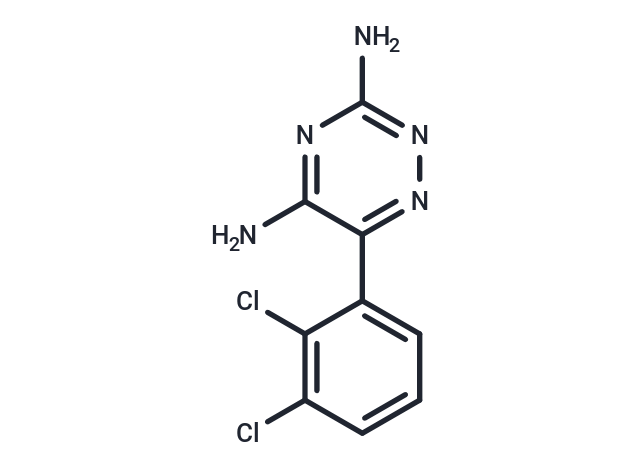Shopping Cart
Remove All Your shopping cart is currently empty
Your shopping cart is currently empty
Lamotrigine (BW430C) is an Anti-epileptic Agent and Mood Stabilizer. The physiologic effect of lamotrigine is by means of Decreased Central Nervous System Disorganized Electrical Activity.

| Pack Size | Price | USA Warehouse | Global Warehouse | Quantity |
|---|---|---|---|---|
| 200 mg | $31 | In Stock | In Stock | |
| 500 mg | $46 | In Stock | In Stock | |
| 1 g | $72 | In Stock | In Stock | |
| 1 mL x 10 mM (in DMSO) | $48 | In Stock | In Stock |
| Description | Lamotrigine (BW430C) is an Anti-epileptic Agent and Mood Stabilizer. The physiologic effect of lamotrigine is by means of Decreased Central Nervous System Disorganized Electrical Activity. |
| Targets&IC50 | 5-HT (rat brain synaptosomes):474 μM, 5-HT (human platelets):240 μM |
| In vitro | Lamotrigine is active in electrically induced EEG after-discharge tests, indicating its ability to counteract simple and complex partial seizures. It demonstrates antiepileptic effects in mice and rats, preventing hind-limb extension induced by both MES (maximal electroshock) and pentylenetetrazole. The peak effects of Lamotrigine occur 1 hour post-administration, with a duration exceeding 24 hours. Intravenous administration of Lamotrigine at doses greater than 5 mg/kg in rats results in a dose-dependent reduction in after-discharge duration. |
| In vivo | In rat cortical brain tissues cultured with 10 mg/L veratridine, Lamotrigine inhibited the release of glutamate and aspartate (both with an ED50 of 5.38 mg/L) twice as effectively as it inhibited the release of GABA (ED50 of 11.2 mg/L), without affecting the basal release of glutamate. Lamotrigine stabilizes presynaptic neuronal membranes by blocking voltage-dependent sodium channels, thereby preventing the release of excitatory neurotransmitters, especially glutamate and aspartate. It does not induce phencyclidine (PCP)-like central nervous system effects, does not act through direct inhibition of NMDA receptors, and may avoid the adverse effects associated with NMDA blockade. |
| Kinase Assay | Whole Cell [3H]R1881 Binding Assay: Fibroblasts are grown to confluence in five or six 150 cm2 tissue culture flasks for routine assay. This usually requires 4-6 weeks from the time of the initial seeding of the cell line. All studies are performed between passages 3-20. Two days before assay, the medium is changed to one lacking fetal calf serum. This is repeated again 24 hours before assay. Competition assays are performed with 0.5-1.0 nM [3H]R1881 and increasing amounts of the nonradioactive compounds. Binding to low affinity sites is determined in the presence of 5 × 10-7 M R1881 and is subtracted from whole cell binding of [3H]R 1881 obtained in the absence of any inhibitor to assess binding to 5 high affinity site |
| Synonyms | LTG, BW430C |
| Molecular Weight | 256.09 |
| Formula | C9H7Cl2N5 |
| Cas No. | 84057-84-1 |
| Smiles | NC1=NN=C(C(N)=N1)C1=CC=CC(Cl)=C1Cl |
| Relative Density. | 1.572 g/cm3 |
| Color | White |
| Appearance | solid |
| Storage | Powder: -20°C for 3 years | In solvent: -80°C for 1 year | Shipping with blue ice/Shipping at ambient temperature. | ||||||||||||||||||||||||||||||||||||||||
| Solubility Information | DMSO: 43.33 mg/mL (169.2 mM), Sonication is recommended. Ethanol: 2.6 mg/mL (10.15 mM), Sonication is recommended. | ||||||||||||||||||||||||||||||||||||||||
| In Vivo Formulation | 10% DMSO+40% PEG300+5% Tween 80+45% Saline: 2 mg/mL (7.81 mM), Sonication is recommended. Please add the solvents sequentially, clarifying the solution as much as possible before adding the next one. Dissolve by heating and/or sonication if necessary. Working solution is recommended to be prepared and used immediately. The formulation provided above is for reference purposes only. In vivo formulations may vary and should be modified based on specific experimental conditions. | ||||||||||||||||||||||||||||||||||||||||
Solution Preparation Table | |||||||||||||||||||||||||||||||||||||||||
Ethanol/DMSO
DMSO
| |||||||||||||||||||||||||||||||||||||||||
| Size | Quantity | Unit Price | Amount | Operation |
|---|

Copyright © 2015-2025 TargetMol Chemicals Inc. All Rights Reserved.